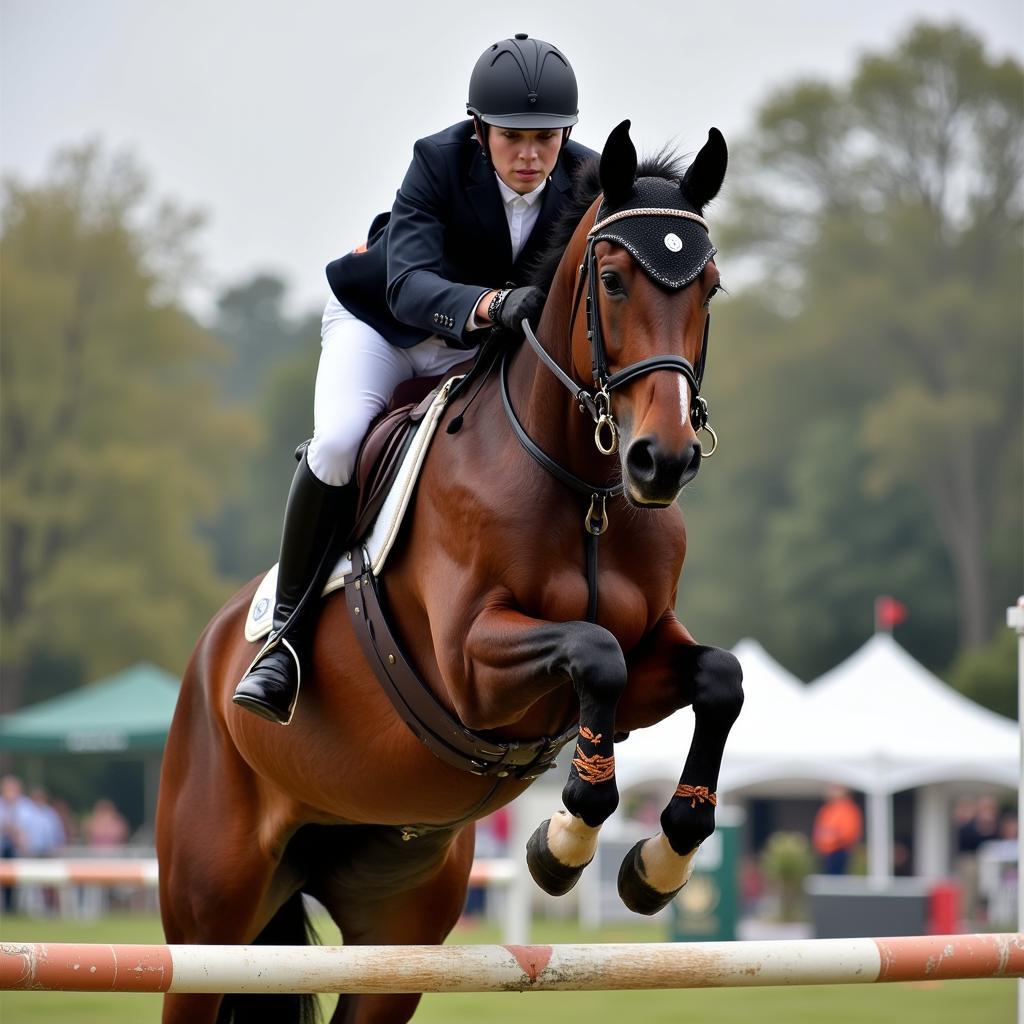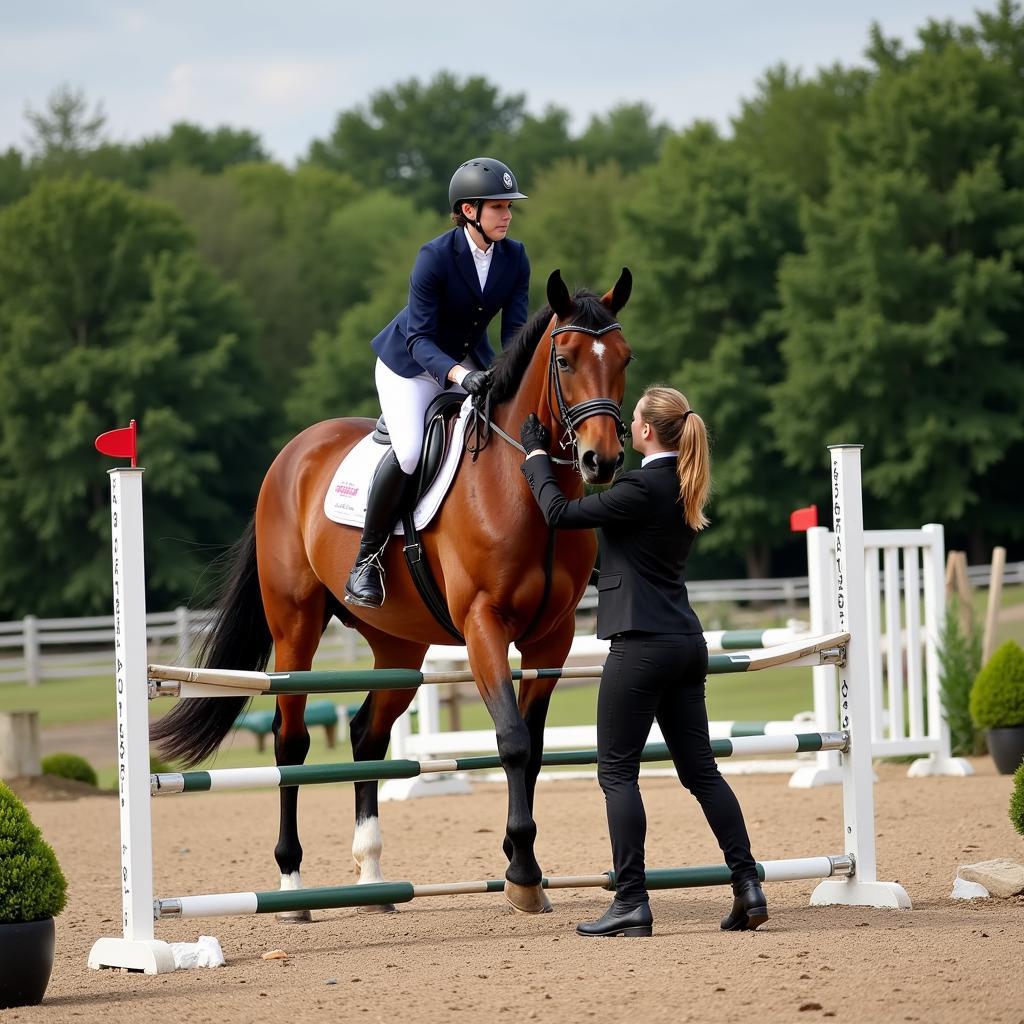Show jumping demands athleticism, carefulness, and a brave heart from a horse. Choosing the Best Breed Of Horse For Show Jumping can significantly impact your success in this exhilarating sport. While many breeds can jump, some have consistently proven themselves as top contenders. This article will explore the characteristics that make certain breeds excel in show jumping and delve into some of the most popular choices.
Choosing the right breed is like picking the right tool for the job. For show jumping, you need a horse with power, agility, and a good temperament. Check out our selection of cute horse stickers to celebrate your love for these amazing animals!
Top Show Jumping Breeds: A Closer Look
Several breeds stand out in the show jumping world, renowned for their exceptional abilities and consistent performance. Let’s explore some of the most popular choices.
Warmbloods: The Show Jumping Stars
Warmbloods, such as the Dutch Warmblood, Holsteiner, and Hanoverian, are purpose-bred for sports like show jumping. They possess a powerful build, athleticism, and a calm temperament, making them ideal partners for this challenging discipline. These breeds are known for their carefulness over fences and their willingness to work with their riders.
- Dutch Warmblood: Known for their athleticism and trainability.
- Holsteiner: Powerful and scopey jumpers with a bold attitude.
- Hanoverian: Elegant and refined with excellent jumping form.
What sets Warmbloods apart is their careful breeding programs that prioritize specific traits for show jumping. This results in horses with the physical attributes and temperament necessary to excel in the sport.
Thoroughbreds: Speed and Endurance
Thoroughbreds, initially bred for racing, often transition successfully into show jumping. Their speed, athleticism, and stamina are valuable assets, especially in timed jump-offs. However, their sensitive nature and high energy levels can sometimes pose challenges for less experienced riders.
- Thoroughbreds excel in speed events.
- They require experienced handling.
- Their athleticism is a major advantage.
Are you curious about other horse breeds? Learn more about the differences between an American Quarter Horse vs Thoroughbred.
Irish Sport Horses: A Blend of Talent
Irish Sport Horses are a popular choice for show jumping, combining the athleticism of Thoroughbreds with the calmer temperament of Warmbloods. This blend of traits makes them versatile and suitable for riders of varying experience levels.
- Irish Sport Horses are versatile athletes.
- They combine speed and carefulness.
- Suitable for both amateurs and professionals.
 Irish Sport Horse Clearing a Jump
Irish Sport Horse Clearing a Jump
Selle Français: French Elegance and Athleticism
The Selle Français, originating from France, is another breed that excels in show jumping. Known for their elegance, athleticism, and calm temperament, they are a popular choice for riders seeking a refined yet powerful partner.
- Selle Français are known for their elegance.
- They are athletic and have a good temperament.
- A popular choice for riders of all levels.
What Makes a Good Show Jumping Horse?
Beyond breed, several key traits contribute to a horse’s success in show jumping.
Temperament and Trainability
A calm and willing temperament is crucial. A horse that is easily spooked or resistant to training will struggle in the demanding environment of show jumping.
Athleticism and Scope
Show jumping requires power, agility, and the ability to clear high fences. A horse with natural athleticism and “scope” – the ability to jump high and wide – has a distinct advantage.
Conformation and Soundness
Correct conformation is essential for soundness and longevity in a show jumping career. A well-conformed horse is less prone to injury and can withstand the physical demands of the sport.
“A good show jumper isn’t just born; it’s made. Careful training and a strong partnership between horse and rider are essential for success,” says renowned equestrian coach, Amelia Hernandez.
 Rider and Horse Training for Show Jumping
Rider and Horse Training for Show Jumping
Conclusion
Selecting the best breed of horse for show jumping involves careful consideration of various factors. While Warmbloods, Thoroughbreds, and Irish Sport Horses are popular choices, ultimately, the best breed depends on the individual rider’s experience, goals, and riding style. Finding the right match between horse and rider is key to achieving success in this challenging and rewarding sport. Explore our range of horse window decals to show off your equestrian pride! Remember, finding the perfect show jumping partner is about more than just breed; it’s about finding a horse that complements your skills and aspirations. If you are located in Illinois and seeking your next show jumping partner, check out our listings for horses for sale Illinois. Our collection of Le Mieux Hobby Horse is a great starting point for young riders.
FAQ
-
What is the average height of a show jumping horse? Show jumpers typically range from 15.2 to 17 hands high.
-
How much does a show jumping horse cost? The price of a show jumping horse can vary widely, from a few thousand dollars to hundreds of thousands, depending on the horse’s breeding, training, and competition record.
-
What age do horses start show jumping? Horses typically begin their show jumping careers between the ages of four and six.
-
What is the most important trait for a show jumping horse? A calm and willing temperament is arguably the most crucial trait, followed by athleticism and scope.
-
How often should a show jumping horse train? The training schedule varies depending on the horse’s age, fitness level, and competition goals, but most show jumpers train several times a week.
-
What equipment is needed for show jumping? Essential equipment includes a saddle, bridle, jumping boots, and a helmet.
-
How can I find a reputable show jumping trainer? Seeking recommendations from other riders, veterinarians, and equestrian professionals is a good starting point.
Common Show Jumping Scenarios
-
Refusal at a jump: This is common, especially with young or inexperienced horses. Riders need to remain calm and encourage their horse to try again.
-
Knocking down rails: This can happen even to experienced horses. It’s important to analyze why the rail was knocked down and adjust training accordingly.
Further Reading and Resources
-
Justus Horses USA Articles: Explore our other articles on horse care, training, and breeds.
-
Local Equestrian Centers: Connect with local equestrian centers for training and competition opportunities.
Contact us for any further assistance! Phone: 0772127271, Email: [email protected]. Visit us at QGM2+WX2, Vị Trung, Vị Thuỷ, Hậu Giang, Việt Nam. Our customer service team is available 24/7.